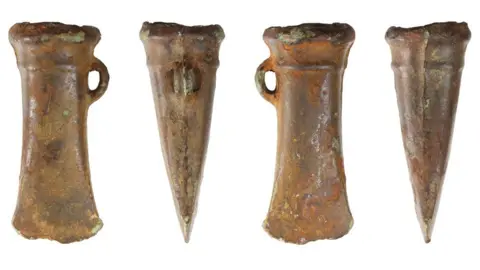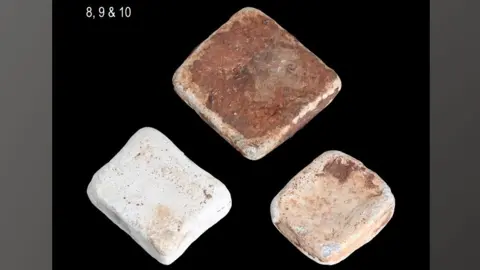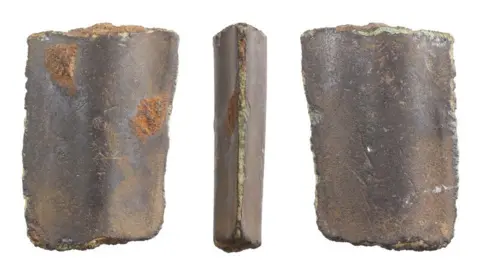Experts excited by Bronze Age lead ingots
 Andrew Williams/Norfolk County Council
Andrew Williams/Norfolk County CouncilLead ingots dating back almost 3,000 years have been found with several broken-up bronze tools in a discovery which has excited experts.
The hoard was unearthed by a metal detectorist near Dereham, Norfolk, between 2019 and 2020, and it is going through the treasure process.
Dr Neil Wilkin, from the British Museum, said it was "very unusual" to find lead ingots from the Bronze Age, despite the material being essential in bronze casting.
The finds date to about 900BCE, when there was a spike in people hiding hoards "for reasons puzzling to us today", he added.
 Andrew Williams/Norfolk County Council
Andrew Williams/Norfolk County CouncilThe cache included four axe heads, one woodworking gouge, casting waste, a fragment of a sword blade and three lead ingots.
"The lead is what people are getting excited about in this particular hoard," said Dr Wilkin, who is the museum's curator for early Europe (Neolithic and Bronze Age collections).
The reason for this was Bronze Age metal smiths worked out the optimum recipe for casting bronze about 3,000 years ago.
The combination of elements was just under 90% copper, about 10% tin and between 1 and 2% lead, he explained.
"That seems like an insignificant amount of lead, but if you talk to people who do experiments with bronze casting today, they say it makes a big difference to the melting point of bronze and its pourability into complex and intricate moulds," he said.
 Andrew Williams/Norfolk County Council
Andrew Williams/Norfolk County CouncilDespite the material's importance, lead has only rarely been discovered at Bronze Age sites or in hoards from the era.
The British Museum has one other Bronze Age lead ingot discovered when its archaeologists excavated a trading site on the River Thames at Runnymede Bridge, near Egham in Surrey, in the 1980s.
Dr Wilkin speculated the discovery site at Dereham might also have been a trading post, due to its proximity to the North Sea.
"There's a lot of evidence that it was quite a specialised craft and the smiths might have been itinerant and might have gone around several different communities creating tools for them," he added.
 Andrew Williams/Norfolk County Council
Andrew Williams/Norfolk County CouncilAll the objects in the hoard were important because they "tell us about that particular moment in time", the curator said.
The woodworking gouge "is similar to gouges found in carpenter's wood kit today", while the sword piece "says something about conflict being an issue at that time".
A coroner at a treasure inquest decides whether a discovery is treasure, and whether a museum should have first refusal over it.
The British Museum is interested in acquiring the hoard.
 Andrew Williams/Norfolk County Council
Andrew Williams/Norfolk County CouncilFollow Norfolk news on BBC Sounds, Facebook, Instagram and X.
